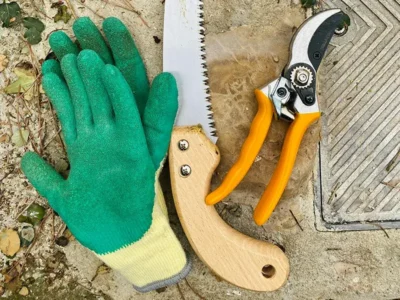You might be wondering if there’s actually a wrong way to prune a tree. Turns out, yes, there is – pruning might sound easy, but it’s unfortunately not as simple as hacking off branches that are in the way and hoping for the best. Improper pruning can lead to unattractive trees, poor landscaping, weak and sickly trees and even death if you really make a hash of it. Here are eight mistakes people commonly make when trimming or pruning a tree, and how to avoid them.
Waiting too long to begin pruning
It’s all too easy to put off pruning until your tree is really getting overgrown and unmanageable, but this is a mistake. You need to start pruning when trees are young, to provide a strong scaffold structure, good trunk development and permanent branch selection. Doing this correctly early on and throughout the various stages of a tree’s life will give the adolescent tree a good form to grow into, that requires few corrective procedures as the tree matures. As well, young trees usually have more dynamic growth habits, and respond to pruning wounds better than mature trees.
Pruning mature trees too harshly
Mature trees (much like mature people) are not as quick to recover from wounding, so great care must be taken when pruning an ageing tree. The amount of live tissue that should be removed will depend on many variables, including tree size, species, age and the goal of pruning (for example, to remove dead, dying, crowded, twisted, rubbing or hazardous limbs, or to reduce the weight of long, heavy limbs). Mature trees might also need to be pruned to allow for light and air penetration inside the tree’s crown to the landscape below, or to provide clearance for structures or services.
Pruning mature trees too harshly can cause irreparable damage to the tree, and can change the way a tree behaves, stores food reserves, uses water and defends itself against attack.
Incorrect pruning technique
Incorrect cuts, such as cutting too close or too far from the trunk, can leave large wounds that won’t heal properly, causing irreversible damage to a tree. Damaging cuts can lead to decay right through the trunk of the tree, which could eventually lead to death if left unchecked. Correct cuts, when performed properly, will minimise the damage done to a tree and allow it to heal quickly, so it’s important to know how to perform them.
Pruning during the growth season
It seems obvious, but trees should be pruned when they’re in their dormant season, not when they are actively growing (from spring until late summer). If you prune a tree during growth season, you risk removing too many leaves and starving the tree of its nutrient-making capacity. As well, harsh pruning can stress the tree, which can be a problem in summer when the tree is already less resilient due to water scarcity. Pruning in summer can also expose branches to the heat of the sun, which can further damage the tree.
Using dull pruning tools
How often do you sharpen your pruning tools? If you’re like most of us, it’s once in a blue moon – but using dull pruning tools can cause significant damage to a tree. Tools that aren’t at their sharpest won’t cut cleanly, but will cut roughly and improperly into the branches, causing wounds to the tree and ripping and shredding the bark. If the edges of the bare wood are looking frayed and jagged, you know that your tools need a good sharpening in order to avoid future problems. Rusty and dirty tools also carry the risk of infecting the tree, particularly if they have previously been used to prune diseased branches.
Over-pruning
While pruning is often necessary, it’s important to keep in mind that every cut you make to a tree is effectively a wound that will need to heal. These cuts create entry points for harmful bacteria and fungi to enter the tree, starting the process of internal rot. As well, removing a tree’s branches means you’re removing necessary resources stored in the tree, reducing the tree’s capacity for photosynthesis and affecting the tree’s future growth. Wood and leaves contain two of the main food sources for the tree, and over-pruning will remove the fuel needed for healthy regeneration and growth. This can lead to a weakened tree that is vulnerable to disease and pest attacks. Any pruning you carry out needs to be done with thought and intention, and should only be done when completely necessary.
Pruning a tree too much or too aggressively can stress a tree significantly, making it more susceptible to disease and sometimes causing the tree to die. Over-pruning is unfortunately a common problem for inexperienced gardeners. It’s far better to understand exactly what type of pruning should be conducted and how to do so properly in order to avoid tree damage.
Chopping the top off a tree
Trees growing too tall can be a problem, but that doesn’t mean you should lop off the top of the tree to keep it manageable. This is a nightmare for a tree, as it will severely stress the tree and cause it to become unbalanced. Once the top of a tree is removed, the tree will usually shoot in several new directions to replace the lost top, and these shoots compete with each other, rather than the tree having one dominant central trunk. This causes the tree to spread out and compromises the structural integrity of the tree, making it more likely to fall under stress. To avoid this, it’s important to consider the height the tree will grow to before you plant it, and plant it in an appropriate space that it won’t outgrow.
Neglecting pruning completely
Going in the opposite direction, one final mistake is to neglect pruning your trees completely. Whether this is due to ignorance, laziness or fear of doing the wrong thing, it’s never a good idea to completely neglect pruning. Though pruning does cause wounds to the tree, these are short-term problems, that are outweighed by the long-term benefits, such as better tree health and aesthetic appeal, and greater safety. Your trees will need pruning at some point – it’s just vital that you do it the correct way.
Proper pruning, with an understanding of tree biology, will help maintain good tree health and structure, while enhancing the aesthetic and economic value of your landscape. Tree pruning should always be done with knowledge about the individual tree in particular and tree biology as a whole, to prevent damaging your trees. If you want to avoid all these mistakes when pruning your trees, get in contact with the pruning, trimming and all things tree care experts at Heritage Tree Care. We know the correct way to prune your trees to ensure their health, aesthetics and safety. Get in contact here for all your tree trimming and pruning needs.


 How we maintain our commitment to the environment
How we maintain our commitment to the environment